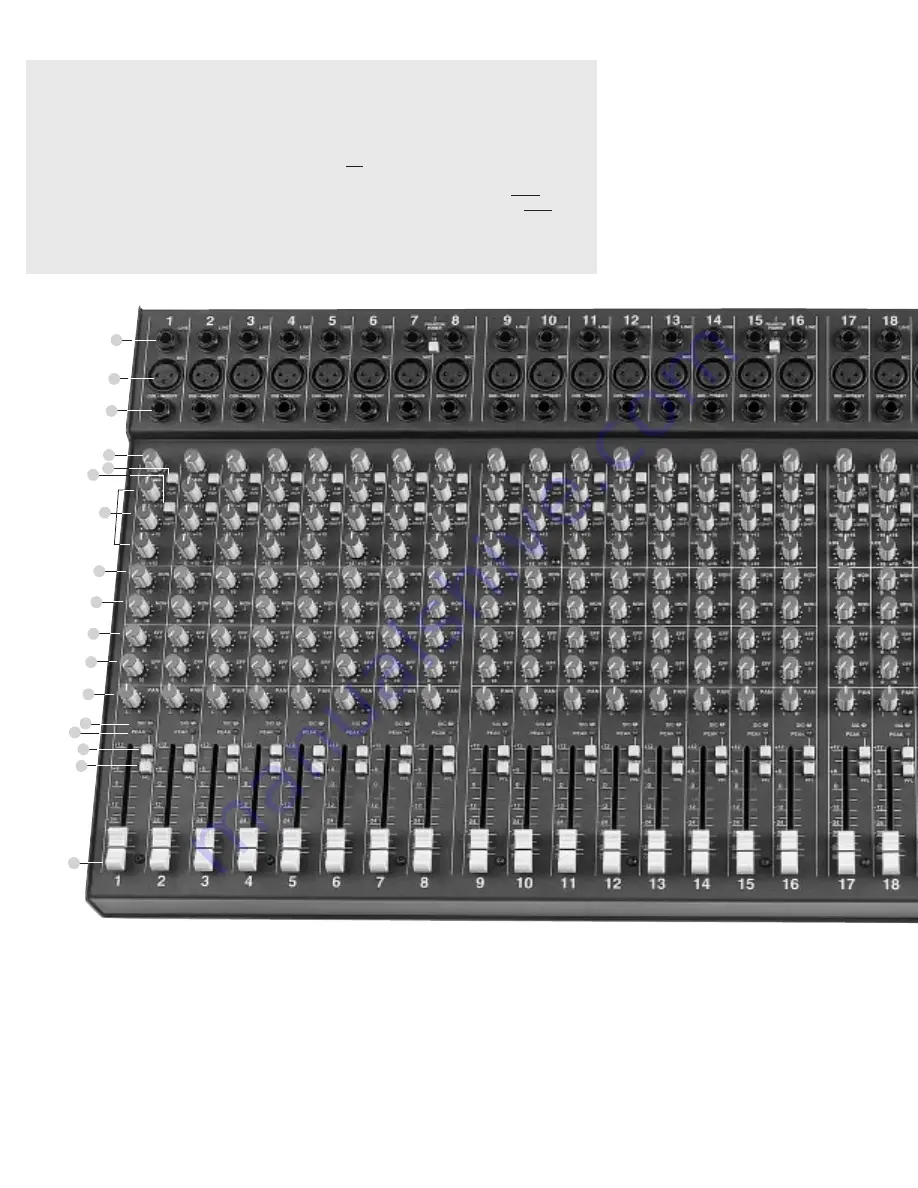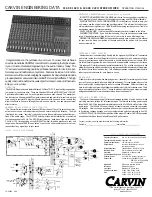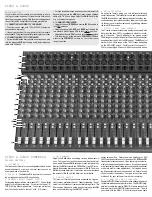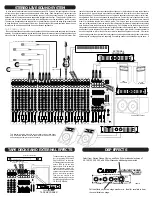
C1600 & C2400 CONTROLS
CHANNEL FEATURES
1. 1/4” LINE IN
The line connectors are for connecting balanced and unbal-
anced instruments, mics, and line level sources such as
drum machines or keyboards.
2. XLR MIC IN
The balanced Mic inputs are for connect-
ing microphones that use XLR connections.
3. CHANNEL INSERT/CHANNEL DIRECT
For inserting channel effects, compressor, ETC. Or, as a direct
output for multi-track recording. For a direct out use a 1/4”
TRS (Tip Ring Sleeve) phone jack. To achieve a direct out
from the channel insert to the first “click” (1/2 insert).
4. GAIN CONTROL
Adjusts the
GAIN
when connecting various instruments &
mics. The type of mic (uni-directional, omnidirectional, etc)
and model will require
GAIN
settings for each individual mic.
Monitor the
GAIN
level with the PEAK LEDs. If an LED is con-
stantly illuminated decrease the amount of
GAIN
. Too much
GAIN
may cause distortion. If distortion is present, decrease
the amount of
GAIN
until the distortion is eliminated.
5. LOW CUT SWITCH
75 Hz low cut filter helps eliminate unwanted low frequen-
cies from any particular channel. Great for reducing “boom”
noise from mic stands or from acoustic/electric guitars. This
filter can also help punch up the bass by turning up the
LOW
tone control while using the
LOW CUT
switch.
6. MID SHIFT SWITCH
An exclusive feature giving you two different midrange
center frequencies. This is ideal for vocals and/or instruments.
The
MID
tone switch on each channel is easier to use than con-
ventional sweep controls because they allow you to compare
for the best vocal or instrument sound by switching between
the two MID frequencies.
7. ACTIVE 3 BAND TONE CONTROLS
The C series mixers provide studio quality tone controls with
distortion less than .009%–exceptionally clean for record-
ing & live sound. The ±15 dB boost or cut give an overall
30 dB range for powerful EQ control. The active circuits deliver
deep bass from the 20-80 Hz
LOW
control. The
MID
control
works in the 2.5k Hz range or the 700 Hz range depending
on the MID SHIFT switch. The
HI
control functions at 11-
20k for crisper highs. Start out with all tone controls at their
center zero position. Determine which position your MID
SHIFT sounds best at,then cut or boost your
HI
,
MID
and
LOW
frequencies for each as needed. If you are trying to mic instru-
ments such as acoustic guitar or drums, try various mics and
mic placement before adjusting your tone controls (condenser
mics work well for these applications). Cutting and boost-
ing frequencies improperly can cause an “un-natural” sound
to your vocals or instruments. Your goal is to achieve a nat-
ural sound for your entire performance or recording.
8. & 9. MONITOR 1 AND 2 CONTROLS
Separate MONITOR level controls for each channel allows you
to create two independent monitor mixes. The MONITOR sig-
nals are routed to the master MON 1 & 2 faders respectively
before going to the MONITOR output connectors. The mix
you create with the MON 1 & 2 controls can also be heard
C1600 & C2400
1
2
3
4
7
8
9
10
11
12
13
14
15
16
17
5
6
QUICK START UP
If you’re like most new owners, you’re probably in a hurry
to plug your mixer in and use it. Here are some brief instruc-
tions to get you going quickly. With the mixer unplugged and
the unit turned off, complete the following procedures:
1. CONNECTING AC POWER TO YOUR MIXER
• The mixer can be used with 120 or 230VAC (it automati-
cally switches internally)
• Use only a grounded (3 prong) power outlet to prevent a
shock hazard. This gives the quietest grounding for your mixer.
2. CONNECTING INPUTS TO YOUR MIXER
• For low level balanced devices such as microphones, plug
into the balanced MIC inputs using a shielded microphone
cable with XLR ends.
• For high level unbalanced devices such as instruments &
Keyboards, plug into the LINE input jacks using a shielded
cable with 1/4” phone plugs. Adjust the GAIN knob for the
mic or line input being used.
3. TURNING YOUR MIXER ON
• Adjust all channel FADERS and master LEVEL controls to
their OFF positions
• Adjust all channel’s HI, MID, and BASS controls and the
two master 9 Band Graphic EQ’s to their center position.
• Adjust all the Channel “PAN” controls to their center position.
• Turn the mixer on by the rear panel POWER SWITCH and
watch for the POWER LED to come on. Your mixer is now
ready to operate.
























